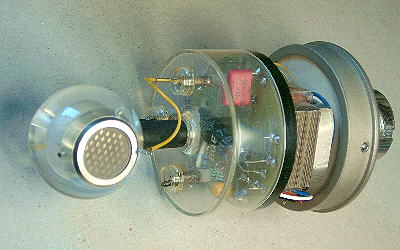Marik
Well-known member
[quote author="riggler"]Burdij, Marik,
How are you determining the proper capsule tension, and how are you providing that tension to the diaphragm when clamping? Dale's method of a washer makes sense..
[/quote]
You can do it whether with Dale's method, or build a tension jig. I think Tim Campbell once posted pics of one.
NO. Capacitance depends on the spacer thickness (distance between diaphragm and backplate) and backplate open area (amount of holes and their diameter).
This one seems kinda messed up. We need to vent the backplate for a certain amount of damping. The atmospheric pressure balance achieved by means of a little cappilar tunnel, connecting the backchamber to the outside.
We don't equalize the response, we damp the resonance.
It is confusing what wents are you talking about? If it uses a moderate tension, then it gotta have lotsa damping for a flat response.
Considering there is 2 micron spacer difference I am not that sure. As a side note, frankly, I don't see a good reason of taking M7 backplate as an example and starting point. It is COMPLETELY different animal and the only resemplance is both M50 and M7 are microphone capsules.
The M7 hole pattern is optimized not only for a damping for CARDIOID mode, but also for a right time delay and is much more complicated. We do not need it in an omni capsule.
Best, M
How are you determining the proper capsule tension, and how are you providing that tension to the diaphragm when clamping? Dale's method of a washer makes sense..
[/quote]
You can do it whether with Dale's method, or build a tension jig. I think Tim Campbell once posted pics of one.
To determine the tension, are you measuring capacitance trying different weights?
NO. Capacitance depends on the spacer thickness (distance between diaphragm and backplate) and backplate open area (amount of holes and their diameter).
1. We need to vent the backplate so that atmospheric pressure won't affect the response -- in essence a change if capacitance.
This one seems kinda messed up. We need to vent the backplate for a certain amount of damping. The atmospheric pressure balance achieved by means of a little cappilar tunnel, connecting the backchamber to the outside.
2. We then drill pits into the backplate to equalize the response of the capsule, countering the resonant frequency.
We don't equalize the response, we damp the resonance.
3. The M50 design does use a vent, and also has a moderate tension on the diaphragm, using the backplate pits and vent to balance the response.
It is confusing what wents are you talking about? If it uses a moderate tension, then it gotta have lotsa damping for a flat response.
4. Burdij must be very close with the backplate drilling and spacing, since his capacitance is close.
Considering there is 2 micron spacer difference I am not that sure. As a side note, frankly, I don't see a good reason of taking M7 backplate as an example and starting point. It is COMPLETELY different animal and the only resemplance is both M50 and M7 are microphone capsules.
The M7 hole pattern is optimized not only for a damping for CARDIOID mode, but also for a right time delay and is much more complicated. We do not need it in an omni capsule.
Best, M

















